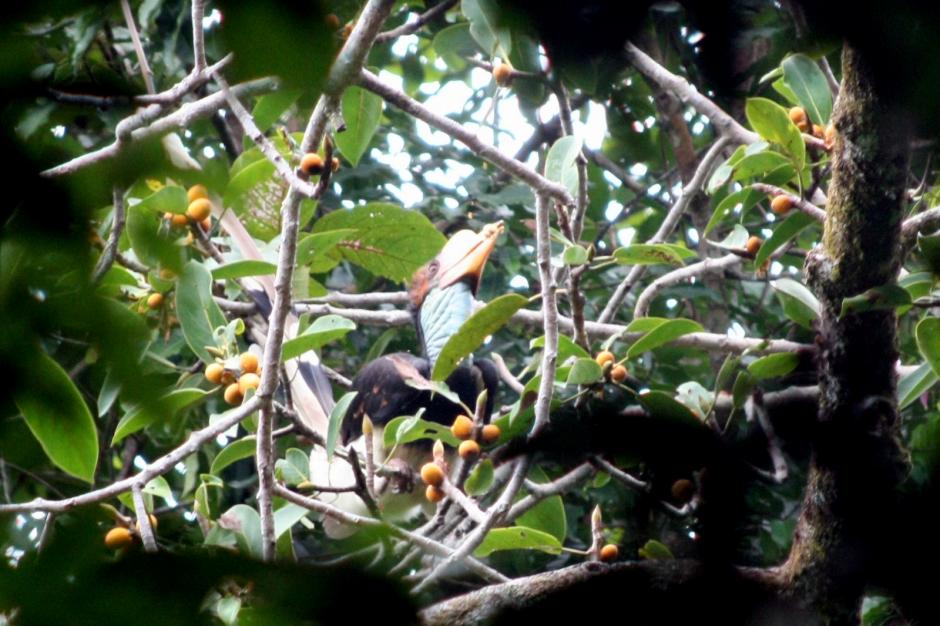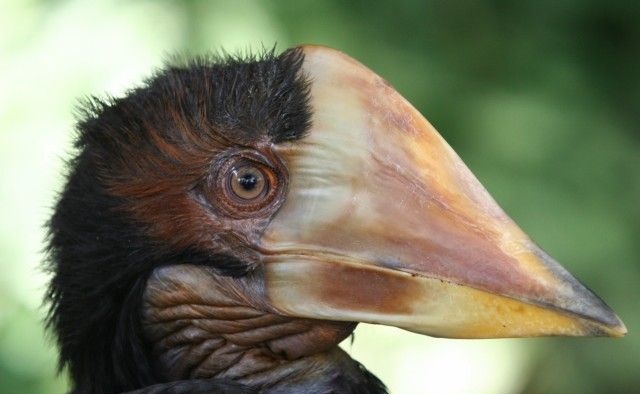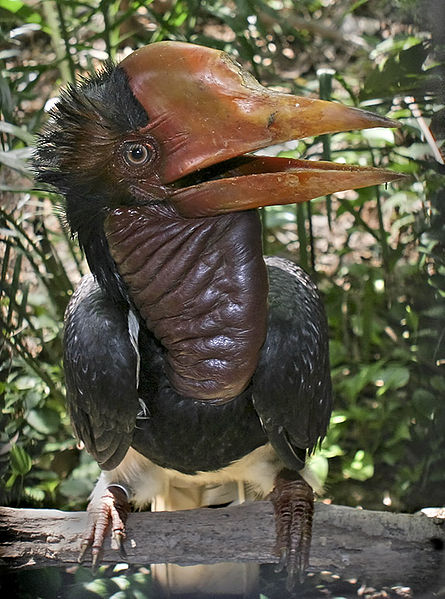Interactions
Now to the single most exciting characteristic of the Buceros vigil, its interactions with other organisms. This bird has numerous interactions that greatly affects the organisms way of life.
In what ways does the Helmeted Hornbill's interact with other hornbills?
The first subject to focus on is how the helmeted hornbill interacts with other hornbills, of its species and of others. The first group to look at will be mating pairs and their interactions.
Mating pairs in the Helmeted Hornbill exhibit many intersting behaviors and interactions between each other that are vital in their success in creating vital offspring. To start, during breeding, the male bird provides food for the female who is confined in the nest. This is an extremely important relationship because of the fact that the male provides the necessary food for the female and the chick The male brings food to the female during her period in the cavity (Eldon 2010). This ensures that the female and chick survive and that for the male, his genes are passed to the next generation. A great video of a male and female Helmeted Hornbill can be found here.
Next, it is good to look at whether or not the Helmeted Hornbill lives individually, in pairs, or rather in larger groups. Typically these birds exist as territorial pairs. Yet occasionally there have been observations of small groups of these birds in contact with each other (Kemp 1995). The pairs are know to make territorial calls and are protective of their area. This occasionally can lead to conflict between the Helmeted Hornbills.
Helmeted Hornbill Aerial Jousting
The Buceros vigil is well known in the avian world for its
rather bizarre aerial jousting interactions between individuals and
occasionally groups. These interactions are typically between males
of the species. These males are observed hitting branches and
rubbing branches with their bills. After hitting the branches the
males take flight in opposite directions and come back towards each
other. At a glide they make impact, casque to caque, and return to
their perches. Observations have been made that prior to taking
flight the birds may exchange calls. These interactions can last as
long as 2 hours and the resulting collisions can be heard as far as
100m away (Kinnaird et al. 2003).
perches. Observations have been made that prior to taking
flight the birds may exchange calls. These interactions can last as
long as 2 hours and the resulting collisions can be heard as far as
100m away (Kinnaird et al. 2003).
Conclusions were made that this sort of behavior has its root for competition for nesting sites and food resources. They was the observation that many of the joustings were in the areas of fig trees and thus could be related to the resource of food the tree provides (Kinnaird et al. 2003).
In what ways does the Helmeted Hornbill's interact with other organisms?
These hornbills have numerous relationships with other organisms. First of all the Buceros vigil shares a predator-prey relationship with many different small animals in its habitat, the Helmeted hornbill being the predator. These include squirrels and even some of the other genus of smaller hornbills (Kemp 1995). They also eat some sorts of insects such as maybe a Polyrhachis lamellidens (an east Asian ant).
While the Helmeted Hornbill is a very large animal in its habitat,
it is still subject to some predation. The biggest predator of this
animal is actually human beings. With its ivory casque and beautiful
feathers men have been know to hunt these birds (Kinnaird and
O'Brien 2007). Hornbills also show very interesting patterns in
their reactions to preadators. From a distance hornbills may provide
a warning call letting the predator know that it is being watched in
a sense. As they approach if they get to close the hornbill may let
out a fright call and flee the predator's range. More serious
predators may illicit silence and a certain hiding of the hornbills
(Kemp 1995).
certain hiding of the hornbills
(Kemp 1995).
Another relationship that these bird have is their ability to disperse seeds. this is a sort of mutualism, meaning bother organisms benefit, because of the fact that the bird is provided with the food it needs and the plant, typically fig trees in the Helmeted Hornbill's case, has its seeds spread to where it can grow (Kemp 1995).
Continue on to learn about the
Buceros vigil's
Fun Facts
or
Head back to the
homepage

